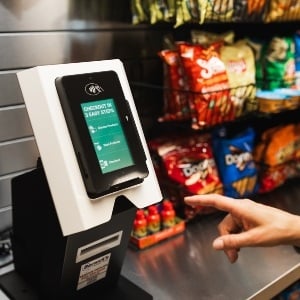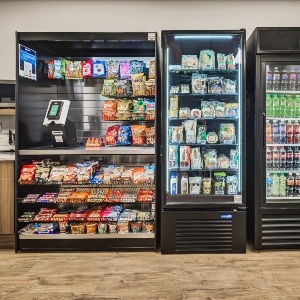What are Micro Markets?
Micro markets are self-service retail spaces that offer a wide range of food, beverage, and convenience items in a communal or workplace setting. They provide a modern alternative to traditional vending machines and are designed to provide customers with a convenient and customizable shopping experience. Micro markets typically consist of open shelving, coolers, display racks, and self-checkout kiosks or payment terminals. Micro market providers typically offer ongoing technical support and maintenance services to address any issues that arise.
Key Features
Self-Service Convenience
Micro markets operate on a self-service model, allowing customers to browse products, make selections, and complete transactions independently. Many micro markets operate 24/7, providing customers with access to products even outside regular store hours. Micro markets often employ security measures such as surveillance cameras and secure payment processing to ensure customer safety.
Diverse Product Selection
Many micro markets focus on offering healthier food and beverage options, catering to the increasing demand for wellness-oriented products. Micro markets offer a diverse array of products, including fresh foods, beverages, snacks, microwavable meals, salads, sandwiches, and more. The selection is often broader and more varied compared to traditional vending machines. Micro markets can be customized to fit the preferences of the specific location and target audience. Owners can curate product offerings to cater to customer preferences.
Interactive Experience
Customers can use touchscreens, self-checkout kiosks, or mobile apps to select items and complete transactions. This interactive element enhances the shopping experience. Micro markets often prioritize cashless transactions, allowing customers to pay using credit/debit cards, mobile wallets, or digital payment methods.
Feedback Data & Analytics
Micro market systems may offer data analytics and reporting features that provide insights into sales trends, popular items, and customer preferences. This data can inform inventory decisions.
Micro markets provide a modern solution for individuals seeking convenient access to a variety of products without the limitations of traditional vending machines. They are particularly popular in settings where customization, extended hours, and a broader selection of items are desired. The concept of micro markets aims to blend the convenience of vending machines with the flexibility and variety of a small retail store.

Efficient Self-Checkout Capabilities

Cutting Edge Inventory Systems

Customized Products and Setups
Benefits of Micro Markets
Micro markets offer a range of benefits for both customers and businesses, making them an attractive option in various settings. Micro markets are a modern and innovative concept that can enhance the appeal of a workplace, office, or other setting.
For Businesses:
Micro markets often generate higher sales per transaction compared to traditional vending machines due to the expanded product selection and customization. The operational design of 24/7 access leads to increased sales during off-peak hours and weekends. They require fewer staffing resources compared to traditional retail stores, as they operate on a self-service model. Micro market systems provide valuable sales data and insights that can inform inventory decisions, helping businesses optimize their offerings. Businesses can tailor their micro market offerings to match the preferences of their target audience, enhancing customer satisfaction. Micro markets generally have lower overhead costs compared to brick-and-mortar retail stores, as they require less space and often no storefront expenses. Micro markets leverage technology for inventory management, payment processing, and reporting, increasing operational efficiency. The self-service nature of micro markets reduces packaging waste, as customers can choose products without excess packaging.
For Customers:
Micro markets offer a wide variety of products, including fresh foods, healthy snacks, beverages, and convenience items. Customers have more choices to cater to their preferences and dietary needs. Customers can choose from a curated selection of products that reflect their tastes. This customization allows for a more personalized shopping experience; self-checkout kiosks and touchscreens create an engaging and interactive shopping experience. Customers can explore products, read labels, and make informed choices. The self-service model of micro markets enables quick and efficient transactions, minimizing waiting times and lines. Micro markets often emphasize healthier food and beverage options, helping customers make mindful choices while on the go. Micro markets can offer fresh foods, such as salads, sandwiches, and fruit, providing customers with a convenient source of nutritious meals. Many micro markets prioritize cashless transactions, making it convenient for customers to pay using credit/debit cards or mobile wallets.
Value for Offices and Workplaces
Micro markets make a lot of sense in office break rooms due to their convenience, customization, and ability to enhance the overall work environment. Micro markets are commonly installed in workplace break rooms, corporate offices, schools, hospitals, and other communal spaces where individuals seek quick and convenient access to refreshments. Installing micro markets in workplaces can improve employee satisfaction by offering convenient access to refreshments and meals. Micro markets operate 24/7 in many cases, providing customers with access to products outside traditional store hours. This is especially useful for shift workers and individuals with varying schedules. Employees often have limited time for breaks, and micro markets provide quick access to a variety of food, beverages, and snacks. This eliminates the need to leave the office premises to find refreshments.
Micro markets allow employers to curate a product selection that caters to the preferences of their employees. This can include healthier options, allergen-free choices, and a variety of cuisines. Micro markets often offer healthier food and beverage options, which align with wellness initiatives that many companies promote. The wide array of products available in micro markets caters to diverse tastes, ensuring that employees can find something they enjoy.
Improve Productivity
Quick access to snacks and beverages can help employees stay energized and focused throughout the workday. Having a micro market on-site reduces the need for employees to leave the office for meals, minimizing disruptions to work. Micro markets save employees time that would otherwise be spent searching for food outside the office, allowing them to maximize their break time. Offering attractive amenities like micro markets can contribute to employee satisfaction and retention. Micro markets can support workplace wellness programs by providing healthier options that align with employees' health goals.
Promote Break Room Activities
Micro markets can serve as social hubs, encouraging employees to interact and collaborate during breaks. Providing a convenient and enjoyable breakroom experience can boost employee morale and create a more positive workplace culture. Micro markets can be customized with branding elements, reflecting the company's identity and values.
Overall, micro markets in office break rooms provide a win-win situation by offering employees a convenient and enjoyable dining experience while benefiting employers through increased employee satisfaction, engagement, and productivity.

How Micro Markets Can Save You Time
Time—the professional unit of measurement by which many important business decisions are made. Micro markets can save business owners time through their self-service model, automated processes, and streamlined operations. They operate on a self-service basis, which means that fewer staff members are required to manage customer transactions and sales compared to traditional retail stores or dining outlets. These systems often include automated inventory tracking. This eliminates the need for manual inventory checks and reduces the time spent on restocking and monitoring product levels.
They offer innovations in real-time data on sales trends, popular items, and customer preferences. Business owners can access this information easily and make informed decisions to optimize their offerings. Many micro market providers offer remote monitoring services. This allows business owners and managers to keep an eye on the micro market's performance, inventory levels, and technical health without being physically present onsite. In that same vein, micro market systems can generate alerts when equipment requires maintenance or technical assistance. This proactive approach reduces downtime and the need for reactive troubleshooting.
When it comes to line-item reporting, micro markets often generate automated reports, such as sales summaries and inventory data. These reports are readily available and save time compared to manual data compilation. This enables business owners to easily update the product selection and pricing through the micro market's management system, eliminating the need for physical price changes and product rotation. With data on popular items and inventory levels, restocking can be targeted and efficient, reducing the time spent on restocking unnecessary items, or committing employee time to handling such tasks.
By automating various aspects of the retail process and leveraging technology, micro markets enable business owners to operate more efficiently, make data-driven decisions, and allocate their time to value-added activities that contribute to the overall success of their business—the time saved from operational tasks related to a micro market can be redirected towards core business operations, customer service, and strategic planning.
How to Increase Sales and Revenue with Micro Markets
Micro markets might seem like a convenience item only, however such vending solutions can increase onsite spending and offer an easy, exploratory way to drive ancillary revenue. Increasing sales and revenue with micro markets requires a strategic approach that focuses on customer engagement, product selection, pricing strategies, and marketing efforts.
By offering a variety of products, including popular snacks, beverages, fresh foods, and healthier options, you’ll appeal to the desires and needs of those you serve. Emphasize healthier choices by placing them prominently and offering nutritional information or highlighting "better-for-you" products to cater to wellness-conscious customers. Ensure you rotate products regularly to keep offerings fresh and exciting; a fun new strategy includes including local and artisanal products within your micro market to create a unique selection. As with other retail ventures, consider implementing tiered pricing for bundled or combo deals to encourage larger purchases, or offer discounts for bulk purchases or loyal customers. Want to capitalize on breakfast or afternoon snacks and caffeine rushes? Consider dynamic pricing that adjusts based on demand or time of day. Consider the long-term effects that a loyalty program that rewards frequent customers with discounts or free items could add to your bottom line.
If your people aren’t aware of what their onsite micro market offers, try a dedicated promotion strategy for your micro market by leveraging your company website and social media platforms. This could include sending email newsletters or blasts on inter-office communication platforms to inform customers about new products, promotions, and special events. What about special discounts or promotions for employees to encourage them to use the micro market? Arrange products in an organized and visually appealing manner to attract attention. Use eye-catching signage and labels to highlight product features, such as health benefits or local origins.
Remember that a combination of these strategies, tailored to your specific micro market and target audience, can lead to increased sales and revenue. Regular attention to your micro market can result in big things for your organization.
Micro Markets and the Hospitality industry
Installing a micro market, a model that can operate 24/7, in a hospitality-based business can offer a range of benefits that enhance the guest experience, increase revenue opportunities, and contribute to the overall appeal of your establishment. Offering a modern, self-service micro market adds an innovative touch to your hospitality business, showcasing your commitment to guest satisfaction. It provides guests with a convenient on-site option for snacks, beverages, and quick meals. This is especially beneficial during off-hours when other dining options might be limited. They offer a wide variety of products, including fresh foods, healthy snacks, beverages, and convenience sundry-based items that seem to be in high demand when away from home. This variety caters to different guest preferences, dietary needs, and whimsy for late-night snacking. Hospitality operators can curate the product selection in the micro market to align with the establishment's branding, themes, and guest preferences. Micro markets can generate additional revenue by offering products for purchase, contributing to the financial success of your business.
By installing a micro market in your hospitality-based business, you provide guests with added convenience, choice, and innovation while creating potential for increased revenue streams and guest satisfaction. This works in-house too; if you're running a larger hospitality establishment, micro markets can also benefit your staff by offering them a convenient place to grab a quick snack or meal. It's important to tailor the micro market's offerings to your target audience and ensure seamless integration into the overall guest experience—and with Bernick’s, it’s easy.
Tips to Run Your Micro Markets Better
Running micro markets effectively involves a combination of efficient operations, customer satisfaction, and strategic decision-making. Here are some tips to help you run your micro markets more successfully:
Keep it Clean & Safe
Keep your micro market clean, organized, and well-maintained, ensuring that refrigeration units, shelving, and payment terminals are in proper working condition and easy to use. Inquire with your distributor partner about regularly scheduled inspections and maintenance checks to address any issues promptly. Proactivity is key. Implement security measures such as surveillance cameras to deter theft and ensure customer safety. Stay updated on industry trends and technological advancements in micro market systems. Embrace innovations that can enhance the customer experience or operational efficiency.
Optimize Products
Arrange products in a logical and visually appealing manner and place high-demand items at eye level to attract attention. Group complementary products together to encourage upselling or bundling. Monitor inventory levels in real-time to prevent sell-outs or overstocking. Set up automated alerts for low-stock items to facilitate timely restocking practices. Regularly review and adjust pricing based on demand, competition, and customer feedback. Provide training to staff or team members responsible for restocking and maintenance, ensuring they understand the technology, inventory management, and customer service aspects of your micro market.
Promote Utilization
Plan and execute promotions that resonate with your target audience considering seasonality and high-demand items or trends; adjust your offerings accordingly. Use signage and digital displays to highlight promotions, new products, and limited-time offers. Analyze sales data and customer preferences to make informed decisions about product selection and pricing.
Food-Friendly Practices
Promote eco-friendly practices, such as using biodegradable packaging or encouraging customers to recycle and consider offering discounts for customers who bring their own reusable containers. Adhere to health and safety regulations related to food handling, storage, and hygiene and be cognizant of any changes in regulations that might impact your micro market operations.
By focusing on these tips and continuously refining your micro market operations, you can create a more seamless, satisfying, and profitable experience for both customers and your business.
Replacing Old Vending Machines with Micro Markets
Replacing old vending machines with micro markets can be a strategic decision that offers various benefits to both customers and your business. Determine your goals for the transition, such as improving customer satisfaction, increasing revenue, and offering a wider variety of products. This means dedicating time and effort to evaluating your current vending machine setup, including their locations, product offerings, and performance. Is the placement within high-traffic areas where micro markets would be most beneficial?
Next, research and select a reputable micro market provider that aligns with your business needs and objectives. Consider factors such as technology, product selection, pricing flexibility, maintenance support, and customer service. Collaborate with the micro market provider to design the layout and setup of the micro markets in your chosen locations. Give careful consideration to the overall setup, so that it is visually appealing, organized, and accessible to customers. Work with your micro market provider to curate a diverse and appealing product mix including customer preferences, dietary needs, and popular items when selecting products. Do you intend to fully replace current vending with a micro market? Consider a phased approach to implementation, starting with a few high-traffic areas. This allows you to gauge customer response and make adjustments before a full rollout, or before developing a complementary vending and micro market combination.
Transitioning from old vending machines to micro markets requires careful planning, effective communication, and a commitment to providing a superior customer experience. By partnering with a reputable and invested distribution partner, you can successfully make the switch and enjoy the benefits of modernizing your refreshment offerings.
Why Choose Bernicks as your Micro Market Vending Service Provider
A successful partnership between businesses and their micro market provider is built on mutual trust, clear communication, shared goals, and a commitment to delivering value to both parties. Bernick’s values open and transparent conversations from the onset about expectations, responsibilities, and any potential challenges. We continually strive to recognize that business needs and customer preferences evolve over time in the dynamic world of food and beverage and work tirelessly to bring the best micro market solutions to our customers.
The Bernick's Partnership Promise
A good partnership stance is built on a foundation of collaboration, trust, and a shared commitment to delivering value to both businesses and their micro market provider. By fostering a positive and open relationship, both parties can work together to create a successful micro market operation that meets customer needs and business goals. Together, we define key performance indicators (KPIs) that measure the success of your micro market operation. This is made possible by establishing clear lines of communication from the outset and maintaining regular check-ins and updates to discuss performance, feedback, and any concerns.
Technology Integration
Choosing a micro market provider like Bernick’s means benefitting from innovative technology and responsive customer support. We ensure that any potential technical issues are addressed promptly to minimize disruptions. We’re committed to continuous improvement by jointly identifying areas for enhancement. This includes regularly assessing the micro market's performance and making necessary adjustments. With our micro market customers, we’ve developed a structured feedback loop where both parties can provide input and suggestions in order to enhance satisfaction for consumers. In transparency, we share relevant sales data, customer feedback, and performance metrics with each micro market customer looking for substantial insight into our process and business principles.
We Both Focus on Your Business
We believe the secret sauce lies within fostering a collaborative environment where both parties contribute ideas and solutions. Respect each other's expertise and contributions to the partnership. Celebrate successes and milestones together. Plan for the long term and consider how the partnership can evolve as the business grows. Encourage brainstorming sessions to optimize the micro market offerings and operations.

